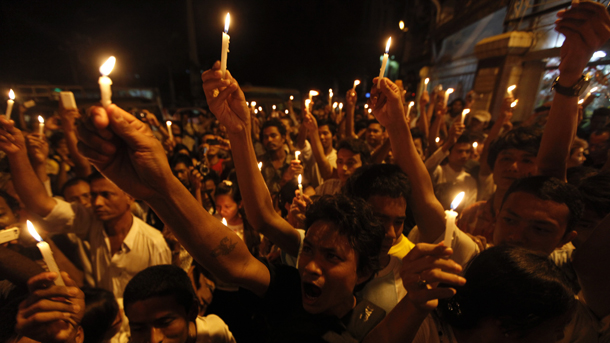RANGOON — Activists in Rangoon plan to again take to the streets with candles to protest government management of the city’s electricity supply, this time voicing opposition to a proposed electricity rate hike of as much as 100 percent.
Activist groups plan to stage their protest—without having obtained the legally required permission—on Wednesday evening at 6pm outside City Hall. They hope to bring attention to what they say is public indignation over a planned rise in the city’s electricity rates even as Burma’s commercial capital continues to experience frequent blackouts.
Last week, the Yangon City Electricity Supply Board (YESB) announced that households consuming more than 101 units of electricity per month would have to pay 50 kyats (US$0.05) per unit, a price increase of about 40 percent.
“The amount is not much for cronies and the upper class but the low-income class has already felt the impact because small and medium-sized businesses have raised the prices of their products due to the electricity price increase,” said Si Thu, an activist organizing Wednesday’s planned protest.
Commercial enterprises that consume from 1 to 5,000 units of electricity per month will experience a 35 percent increase and pay 100 kyats per unit starting in November, YESB also announced. Businesses using more than 5,000 units will see their electricity bills double as rates jump from 75 kyats to 150 kyats per unit.
“There will be two groups protesting,” Si Thu said. “One will be in front of Konezaytan Street, near Theingyi Market, to collect people’s input as to whether they will accept the increase or not. Another group will be at City Hall and will march through Kyauktada Township.”
Min Nay Htoo, another activist coordinating the demonstration, said organizers were bracing for a potential crackdown by local authorities, given that no permit for the protest was granted by the city government.
“We are not afraid because we are acting on behalf of the people who will suffer the impacts of this electricity price rise. The daily commodities prices are now getting higher because of this. How can low-income people survive?” 21-year-old Min Nay Htoo told The Irrawaddy.
The YESB said in its announcement last week that it was implementing the price hikes “in order to cover costs of producing and purchasing electricity.” The board could not be reached for further comment on the price increase.
Protestors from several townships in Rangoon are expected to participate.
“We know about Section 18,” Si Thu said, referring to a provision of the Peaceful Assembly Law that requires prior approval from local authorities for any planned protest. “We can be arrested, but we will do it because we don’t want to see people facing difficulties. We hope that the government will change course through this protest.”
Activists in Rangoon and central Burma staged similar candle protests last year in May, at the tail end of the dry season, when the country was afflicted by particularly acute power cuts. At least six people were arrested
In late September, Union Minister for Electricity Khin Maung Soe said current energy supply stands at about 2,000 megawatts per day nationwide, while energy demand far outstrips supplies and is set to grow 15 percent annually, to 4,900 megawatts per day by 2015. Rangoon represents more than half of Burma’s energy demand.
During the dry season, from October to May, YESB struggles to supply Rangoon’s approximately 5.3 million inhabitants and it is forced to ration electricity supply. Some parts of the city receive only six hours of power per day.

















